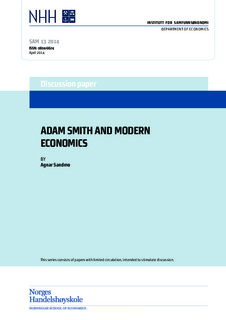| dc.contributor.author | Sandmo, Agnar | |
| dc.date.accessioned | 2014-05-02T12:37:15Z | |
| dc.date.available | 2014-05-02T12:37:15Z | |
| dc.date.issued | 2014-04 | |
| dc.identifier.issn | 0804-6824 | |
| dc.identifier.uri | http://hdl.handle.net/11250/194583 | |
| dc.description.abstract | In his Wealth of Nations (1776) Adam Smith created an agenda for the study of the economy
that is reflected in the structure of modern economics. This paper describes Smith’s
contributions to four central areas of economic theory: The theory of price formation, the
relationship between market outcomes and the public interest, the role of the state in the
economy, and the sources of economic growth. In each case, an attempt is made to relate
Smith’s contribution to the state of contemporary economics, showing both the similarities
and contrasts between the respective approaches. | nb_NO |
| dc.language.iso | eng | nb_NO |
| dc.publisher | Norwegian School of Economics. Department of Economics | nb_NO |
| dc.relation.ispartofseries | Discussion paper;13/2014 | |
| dc.subject | VDP::Samfunnsvitenskap: 200::Økonomi: 210::Samfunnsøkonomi: 212 | nb_NO |
| dc.subject | Adam Smith | nb_NO |
| dc.subject | markets | nb_NO |
| dc.subject | government | nb_NO |
| dc.subject | economic growth | nb_NO |
| dc.title | Adam Smith and modern economics | nb_NO |
| dc.type | Working paper | nb_NO |
| dc.subject.jel | B12 | |
| dc.subject.jel | B31 | |
